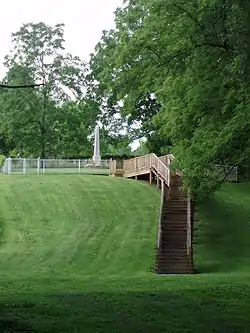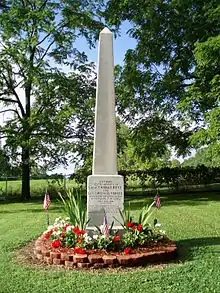Boyd and Parker ambush
The Boyd and Parker ambush was a minor military engagement in Groveland, New York on September 13, 1779, during the American Revolutionary War. A scout group of the Sullivan Expedition was ambushed and captured by Loyalists and their Seneca Indian allies led by Little Beard.
| Boyd and Parker ambush | |||||||
|---|---|---|---|---|---|---|---|
| Part of the American Revolutionary War | |||||||
 Groveland Ambuscade Park commemorating the ambush | |||||||
| |||||||
| Belligerents | |||||||
|
|
| ||||||
| Commanders and leaders | |||||||
|
|
| ||||||
| Strength | |||||||
| 24 | Unknown | ||||||
| Casualties and losses | |||||||
|
14 killed 2 captured and killed 8 escaped |
1 Iroquois Killed 1 Iroquois wounded | ||||||
Background
Native American raids in Upstate New York compelled General George Washington to send General John Sullivan with some 3500 men into Western New York to displace the Senecas; destroy their crops, villages, and food supplies; and remove the threat to settlers.
Prelude
Iroquois Chief Joseph Brant and British Colonel John Butler had some 800 men and were in defense of the region. Sullivan marched from Easton, PA through Pennsylvania and into Western New York. They camped at the site of Foot’s Corners in Conesus on Sunday, September 12, 1779, after traveling from Honeoye Lake. That night Sullivan ordered Lt. Thomas Boyd to organize a scouting party to discover the location of the Seneca village. Boyd took 23 men with him including Sergeant Michael Parker. They left late that night and passed by Butler’s ambush party without either group knowing of the other.
Ambush
During the next day the scouting party spotted a group of four Indians along the trail and a brief gun fight occurred. One Indian was killed, and Boyd and Parker started to return to Sullivan. On the trail they spotted five Indians who fled. Boyd’s guide told him not to follow, for it was a trap, but he ignored the warning. They were led into the enemy’s lines, surrounded, and outnumbered. Fifteen of Boyd’s men were killed, eight escaped, while Boyd and Parker were captured. Estimates from contemporary Journals is that the Boyd party numbered 29 of whom 17 were killed; 5 returned and 7 escaped.[1]
Besides Boyd and Parker, there are 12 known names of Boyd-Parker party who were killed.;[2] one name on this monument "Corporal Calhoun" refers to a NCO who died of wounds in an ambush which occurred separate from the Boyd-Parker ambush.[1]
The two were taken to Little Beard's Town, now Cuylerville, where Brant questioned them. After he left, Little Beard and his men tortured and executed Boyd and Parker in anger over the presence of American troops in the area. Boyd was tied to a tree by his own intestines and forced to run around the tree until he fell dead. The tree is still located in the commemorative park.
Aftermath

Two days later the ambush site was discovered by Sullivan’s army and the men were buried with military honors. The army went on, as instructed by George Washington,[3] to destroy acres of crops and burn Little Beard’s town to the ground. Many of the men in the army were so impressed with the agricultural value of the land that they returned with their families to this region after the war.
Memorials
The bodies of Boyd and his men were left at the site of the battlefield until 1841, when they were re-interred at Rochester, New York's Mount Hope Cemetery in a ceremony hosted by New York Governor William H. Seward.[4]
Today the Groveland Ambuscade Monument marks the site along with a small town park, which is listed on the National Register of Historic Places. In September 2004 the site commemorated the event's 225th anniversary with a series of reenactments.
Notes
- Little Beard biography and death in 1806
- Boyd and Parker memorial page
- Boyd/Parker Party memorial page
References
- "Archived copy". Archived from the original on 2008-09-08. Retrieved 2009-08-19.CS1 maint: archived copy as title (link)
- "Vintageviews.org". Archived from the original on 2008-10-11. Retrieved 2007-11-13.
- "Sullivan/Clinton Campaign". Then and Now.
- Peck, William (1908). History of Rochester and Monroe county, New York. Pioneer Publishing Company. pp. 23. Retrieved 2009-04-05.